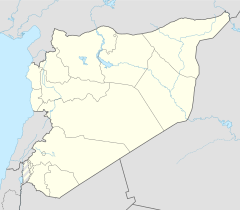
Back Meuseujid Umayyah ACE Omajjadiese Moskee Afrikaans الجامع الأموي (دمشق) Arabic جامع بنى اميه الكبير ARZ Mezquita de los Omeyes AST Омавиязул мажгит AV Əməvi məscidi Azerbaijani Өмәүиҙәр мәсете Bashkir Омаядска джамия (Дамаск) Bulgarian উমাইয়া মসজিদ Bengali/Bangla
| Umayyad Mosque | |
|---|---|
الْجَامِع الْأُمَوِي | |
 | |
| Religion | |
| Affiliation | Islam |
| Status | Intact |
| Location | |
| Location | Damascus, Damascus Governorate |
| Country | Syria |
Courtyard of the Umayyad Mosque in Old Damascus | |
| Geographic coordinates | 33°30′41″N 36°18′24″E / 33.51139°N 36.30667°E |
| Architecture | |
| Type | Islamic |
| Style | Umayyad |
| Completed | 715 CE |
| Specifications | |
| Minaret(s) | 3 |
| Minaret height | 77 m (253 ft) |
| Materials | Stone, marble, tile, mosaic |
| Official name | Ancient City of Damascus |
| Type | Cultural |
| Criteria | i, ii, iii, iv, vi |
| Designated | 1979 (3rd session) |
| Reference no. | 20 |
| Region | Arab States |
The Umayyad Mosque (Arabic: الجامع الأموي, romanized: al-Jāmiʿ al-Umawī), also known as the Great Mosque of Damascus, located in the old city of Damascus, the capital of Syria, is one of the largest and oldest mosques in the world. Its religious importance stems from the eschatological reports concerning the mosque, and historic events associated with it. Christian and Muslim tradition alike consider it the burial place of John the Baptist's head, a tradition originating in the 6th century. Two shrines inside the premises commemorate the Islamic prophet Muhammad's grandson Husayn ibn Ali, whose martyrdom is frequently compared to that of John the Baptist and Jesus.
The site has been used as a house of worship since the Iron Age, when the Arameans built on it a temple dedicated to their god of rain, Hadad. Under Roman rule, beginning in 64 CE, it was converted into the center of the imperial cult of Jupiter, the Roman god of rain, becoming one of the largest temples in Syria. When the empire in Syria transitioned to Christian Byzantine rule, Emperor Theodosius I (r. 379–395) transformed it into a cathedral and the seat of the second-highest ranking bishop in the Patriarchate of Antioch.
After the Muslim conquest of Damascus in 634, part of the cathedral was designated as a small prayer house (musalla) for the Muslim conquerors. As the Muslim community grew, the Umayyad caliph al-Walid I (r. 705–715) confiscated the rest of the cathedral for Muslim use, returning to the Christians other properties in the city as compensation. The structure was largely demolished and a grand congregational mosque complex was built in its place. The new structure was built over nine years by thousands of laborers and artisans from across the Islamic and Byzantine empires at considerable expense and was funded by the war booty of Umayyad conquests and taxes on the Arab troops of Damascus. Unlike the simpler mosques of the time, the Umayyad Mosque had a large basilical plan with three parallel aisles and a perpendicular central nave leading from the mosque's entrance to the world's second concave mihrab (prayer niche). The mosque was noted for its rich compositions of marble paneling and its extensive gold mosaics of vegetal motifs, covering some 4,000 square metres (43,000 sq ft), likely the largest in the world.
Under Abbasid rule (750–860), new structures were added, including the Dome of the Treasury and the Minaret of the Bride, while the Mamluks (1260–1516) undertook major restoration efforts and added the Minaret of Qaytbay. The Umayyad Mosque innovated and influenced nascent Islamic architecture, with other major mosque complexes, including the Great Mosque of Cordoba in Spain and the al-Azhar Mosque of Egypt, based on its model. Although the original structure has been altered several times due to fire, war damage, and repairs, it is one of the few mosques to maintain the same form and architectural features of its 8th-century construction, as well as its Umayyad character.
| Old City of Damascus |
|---|
| Location of the Mosque in Relation to the Citadel and the Azem Palace |
© MMXXIII Rich X Search. We shall prevail. All rights reserved. Rich X Search


